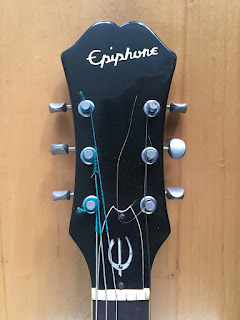Gallagher this particular model remains popular among collectors.
It should be all original. This one came to me in a bad condition.
There were deep carvings in the neck and back. At that time it
seems to be cool behaviour to treat your guitar this way and
having placed DiMarzio's on it! On this guitar they did some
work on the cavity for the bridge pick up but it is not visible
at the outside at this moment
seems to be cool behaviour to treat your guitar this way and
having placed DiMarzio's on it! On this guitar they did some
work on the cavity for the bridge pick up but it is not visible
at the outside at this moment
This instrument now has the old ease of playing again.
Due to the scratches and carvings the neck didn't
had a nice feeling anymore and I figured it
had to be playable in the first place! The back of
the body has been provided with some layers of
clear lacquer so no staining process.
the body has been provided with some layers of
clear lacquer so no staining process.
As this guitar has been put up for sale I will describe it as
securely as possible. The back of the head with its' original
tuners. As for the screws: I don't know....
As I stated earlier the neck has been refinished and also the
stain had to be removed so this spot might be interesting to
potential buyers. For collectors it all comes about originality.
And another shot of this neck / body construction. Be aware!
This is the original neck and NOT a replacement. The number
on the back of the head is a match with the sticker inside.
This is a real player and if someone is planning to make
it "road worn" - It looks a bit like a pity to me!
The back really wasn't that bad and then
the original staining process still is there.
Another possible issue could be the neck / body angle
which can result in a too low bridge placement. To my
opinion in fact too high in order to have the magnetic
poles right under the strings so I placed a plastic ring
underneath the metal caps of the pick ups in order to
get a stronger signal.
The angle is a good one as this picture proves.
And here the neck pick up and the distance to the strings.
I haven't played this guitar that much though I know
that about the lowest 5 to 7 frets have been replaced.
The neck bindings however are intact! Width of the
nut: 41 mm what in fact makes it too narrow for
me as a mainly classical guitar player. Never any
damage there as a repaired neck is not uncommon.
The front of the head that has been refinished
as well. Original truss rod cover and topnut.
It might be another issue: I'm not sure wether if all
knobs are out of 1967. The switch is from 1967 as are
the capacitors and pots. A lot of these guitars lost their
scratchplate and the prefix on it: "E". It is all still
there on this example.
This guitar came with a frequensator tailpiece in fact not
uncommon on these type of guitars. In order to have less
tension in the higher strings once tuned, a player could
change the two parts. Original bridge and pick-up caps.
This old lady aged gracefully so some traces in
the lacquer are inevitable. It "crazed" a bit.
Therefore another spot that shows this effect.
The original blue label and the number of this guitar.
At that time the Kalamazoo workforce was responsible
for these guitars. Original model nr. E230TD. This
number corresponds with that printed on the back
of the head.


















No comments:
Post a Comment